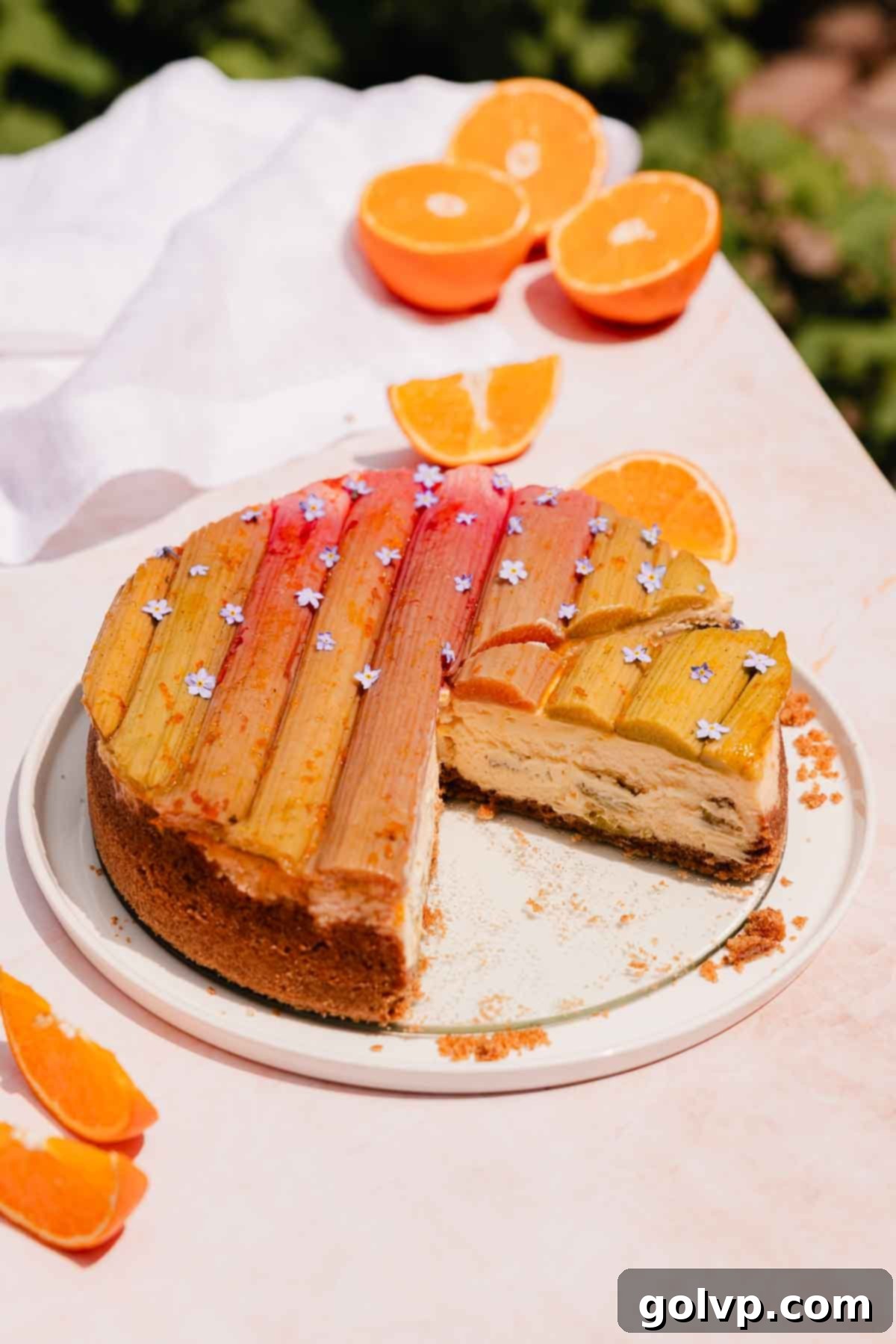The Ultimate Vanilla Orange Roasted Rhubarb Cheesecake: A Guide to Creamy Perfection
Prepare to be enchanted by this exquisite Vanilla Orange Roasted Rhubarb Cheesecake, a dessert that perfectly marries the vibrant tang of fresh rhubarb with the luscious creaminess of a classic baked cheesecake. This show-stopping treat features layers of delicate vanilla bean and zesty orange-infused roasted rhubarb, both within the cheesecake filling and as a stunning topping. The delightful contrast between the tart fruit and the rich, decadent cheesecake creates an unforgettable flavor experience that truly celebrates the best of rhubarb season. We’ll guide you through every step, sharing expert tips and tricks to ensure your cheesecake is flawlessly creamy, perfectly set, and utterly delicious, complete with a beautifully golden, subtly spiced graham cracker crust.
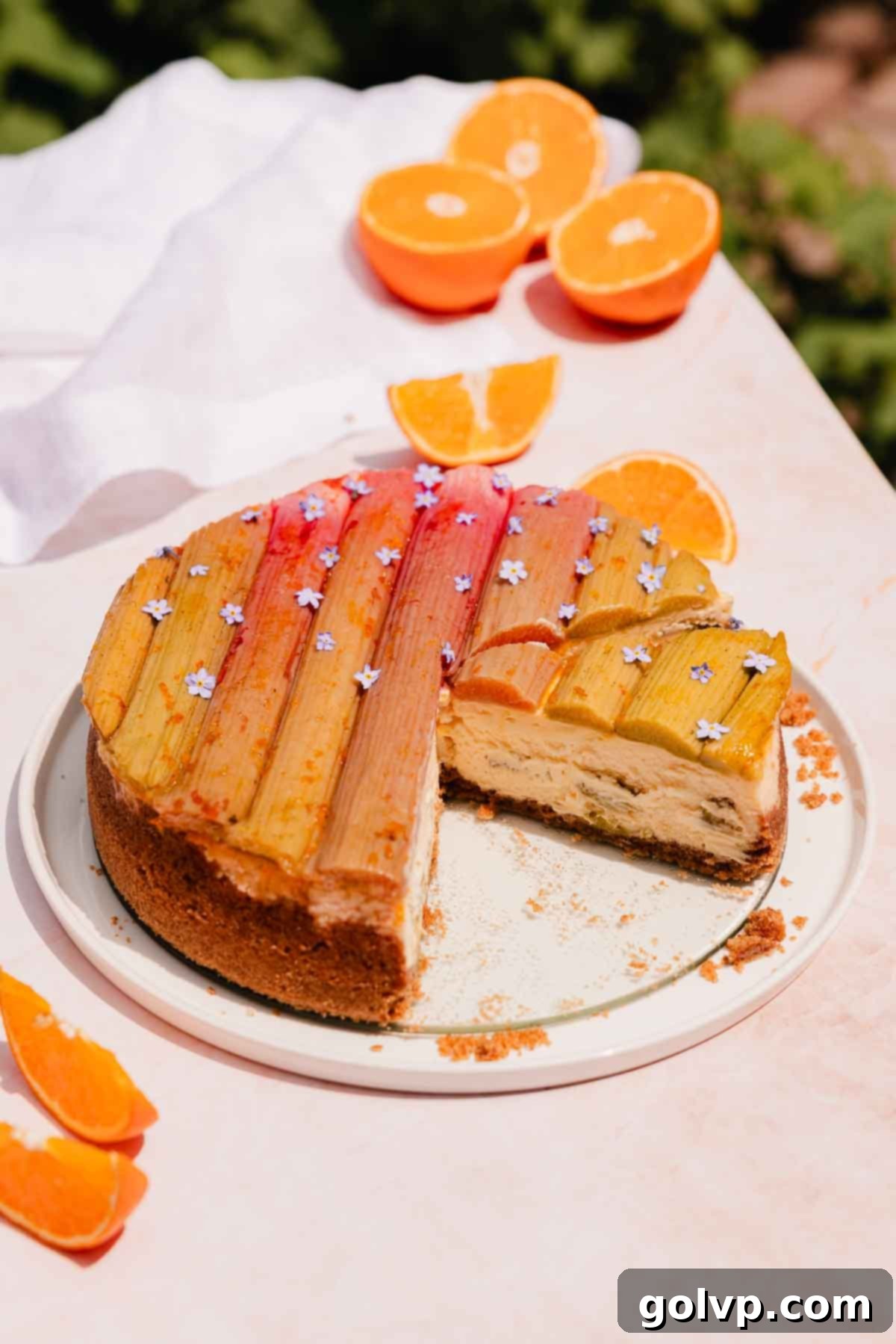
🍰 Why You’ll LOVE This Rhubarb Cheesecake Recipe
- Vanilla Bean Orange Roasted Rhubarb: This recipe elevates rhubarb to new heights. Roasting the rhubarb concentrates its naturally tart flavors and transforms it into perfectly tender, juicy pieces. Infused with aromatic vanilla bean and bright, freshly zested and juiced orange, the rhubarb develops a complex, caramelized flavor profile that beautifully complements the creamy cheesecake. The citrus notes provide a delightful zestiness, while the vanilla adds a warm, sweet undertone, making every bite a burst of exquisite flavor.
- Elevated Graham Cracker Crust: Forget your average crust! We take the classic graham cracker crust and enhance it with a touch of brown sugar and a hint of cinnamon. This subtle addition of warm spices and molasses-rich sweetness adds an extra layer of flavor, perfectly balancing the tartness of the rhubarb and the richness of the cheesecake. The result is a buttery, crisp crust that provides an ideal foundation for this luxurious dessert.
- Incredibly Creamy Baked Cheesecake: Achieving a perfectly creamy baked cheesecake can be daunting, but with our detailed instructions and tips, you’ll master it. This vanilla cheesecake boasts an irresistibly smooth, velvety texture that melts in your mouth. We layer chunks of the flavorful roasted rhubarb through the center, ensuring that every slice offers a delightful combination of creamy vanilla and tangy fruit. It’s a decadent treat that’s surprisingly straightforward to achieve.

📝 Key Ingredients for a Perfect Rhubarb Cheesecake
Read through for all the tips you will need for success!
Full steps and ingredients in the comprehensive recipe card below.
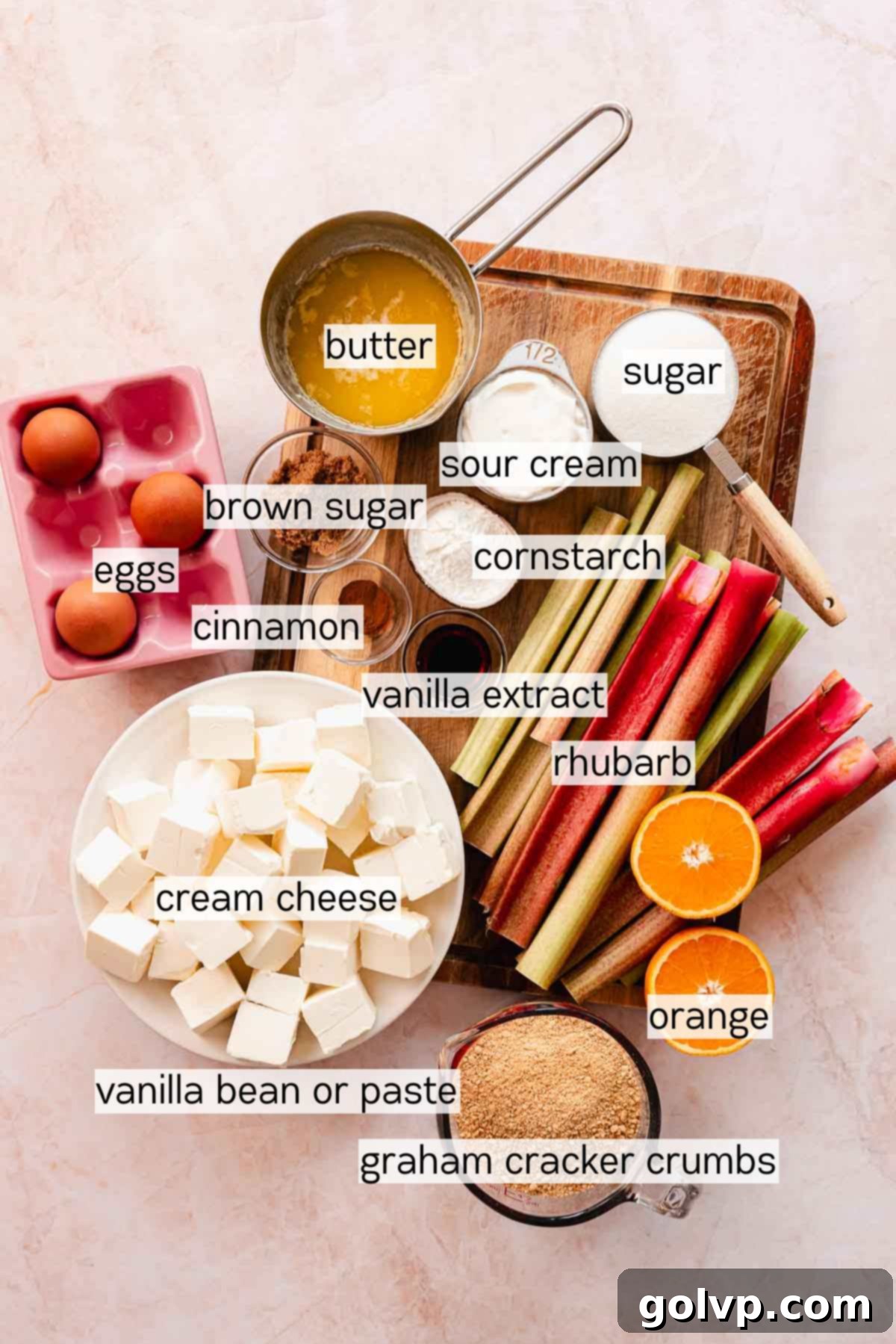
Cream Cheese: For the ultimate creamy, rich, and decadent cheesecake texture, always opt for full-fat, brick-style cream cheese. Avoid whipped or spreadable cream cheese, as these contain too much air and moisture, which can lead to a less stable and less flavorful cheesecake. Ensure your cream cheese is at room temperature before mixing to achieve a perfectly smooth, lump-free batter.
Rhubarb: Fresh rhubarb is ideal for its beautiful pink and green hues, which make for a stunning presentation, especially when creating the decorative topping. Look for firm, crisp stalks. If fresh isn’t available, frozen rhubarb chunks can be used in the same way for the roasted rhubarb component that goes into the cheesecake filling. Note that frozen rhubarb may roast slightly faster due to its higher water content.
Orange: Both the fresh juice and zest from one orange are crucial for adding a bright, zesty, and slightly caramelized flavor to the roasted rhubarb. The natural acidity of the orange also helps to enhance the rhubarb’s tanginess, creating a more complex and balanced fruit layer. Don’t skip the zest, as it holds most of the aromatic oils!
Graham Cracker Crumbs: These form the base of our delicious crust. Pre-crushed graham cracker crumbs offer convenience, but you can also crush whole crackers yourself for a slightly coarser texture. Their inherent warm, slightly sweet flavor is perfectly complemented by the addition of cinnamon and brown sugar, making a robust and flavorful crust that stands up to the creamy filling.
Sour Cream: This ingredient is key to achieving an ultra-creamy, rich cheesecake flavor and texture. Full-fat sour cream adds a subtle tang that balances the sweetness of the cheesecake and contributes to its silky-smooth consistency. Like cream cheese, ensure it’s at room temperature for optimal blending.
Vanilla Bean Paste: While vanilla extract is good, vanilla bean paste offers a superior, more intense vanilla flavor and those beautiful, irresistible black specks that signify true vanilla indulgence. If you happen to have a whole vanilla bean, you can scrape the seeds from half a pod (or a whole one, if you desire) for an even richer aroma and flavor. Vanilla bean paste is generally easier to work with and provides consistent results.
Cornstarch: This acts as a stabilizer, playing a vital role in preventing the cheesecake from cracking during baking and ensuring it sets to that perfect, creamy consistency. It helps absorb excess moisture and provides structural integrity. If you’re planning to freeze the cheesecake, or prefer alternatives, potato starch or arrowroot starch are excellent substitutes as they tend to hold up better to freezing and thawing without altering the texture.
👩🍳 How to Make This Delicious Rhubarb Cheesecake: Step-by-Step Guide
Vanilla Orange Roasted Rhubarb Step-by-Step
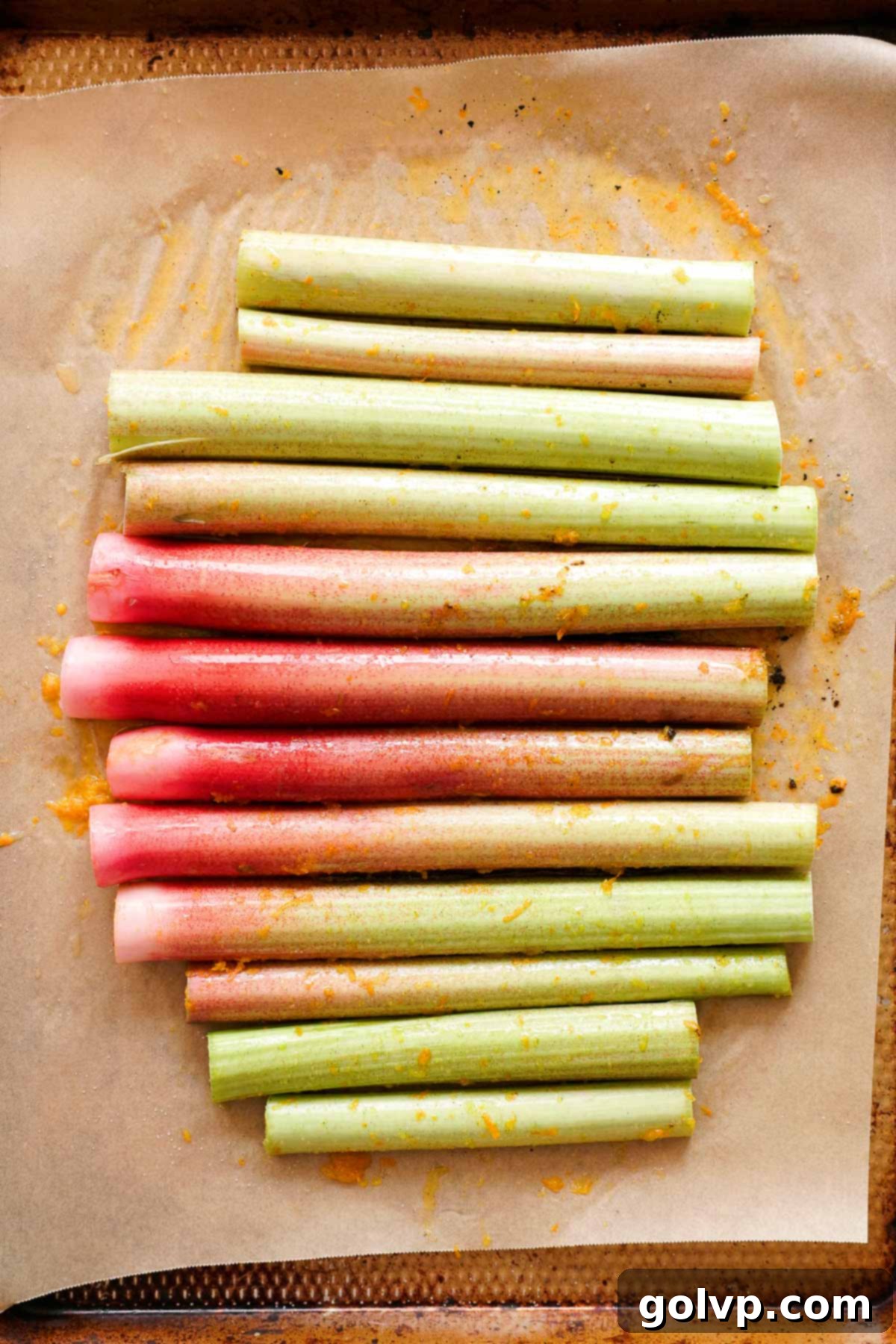
Step 1: Prepare and Flavor the Rhubarb. Begin by preheating your oven to 320°F (160°C). Lay your chopped rhubarb stalks evenly on a baking sheet lined with parchment paper. Sprinkle the granulated sugar, vanilla paste (or scraped vanilla bean seeds), grated orange zest, and freshly squeezed orange juice over the rhubarb. Gently toss the mixture to ensure all the rhubarb pieces are thoroughly coated. If you have particularly thick rhubarb stalks, consider slicing them in half lengthwise to ensure even roasting and tenderness.
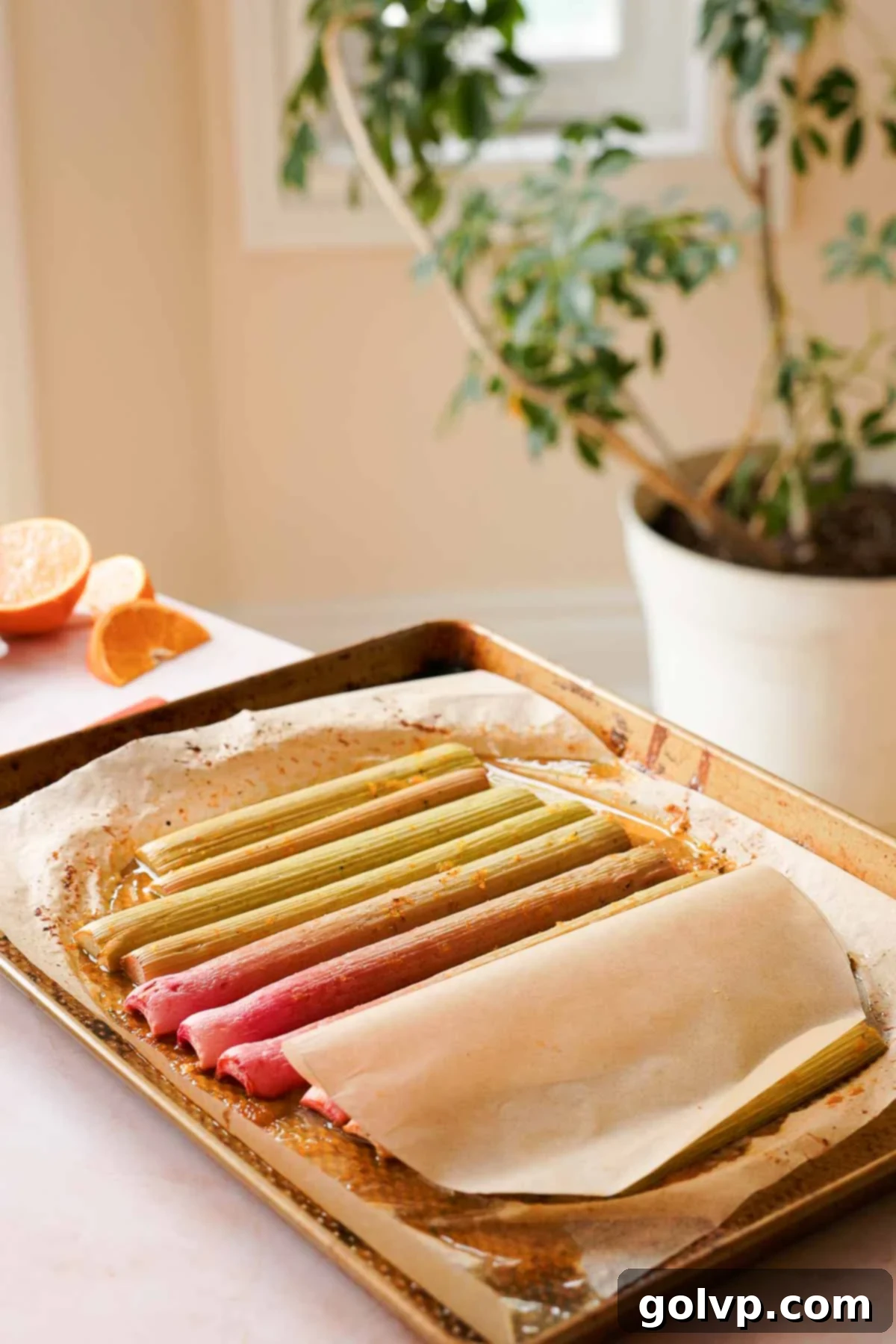
Step 2: Roast the Rhubarb to Perfection. Transfer the baking sheet to the preheated oven and roast the rhubarb for approximately 20 minutes. The goal is for the rhubarb to be tender when gently poked with a knife, but still firm enough to hold its shape. Over-roasting will cause it to become mushy, which we want to avoid for both texture and presentation. Start checking for doneness after 18 minutes, and then every few minutes thereafter, to achieve the ideal texture.
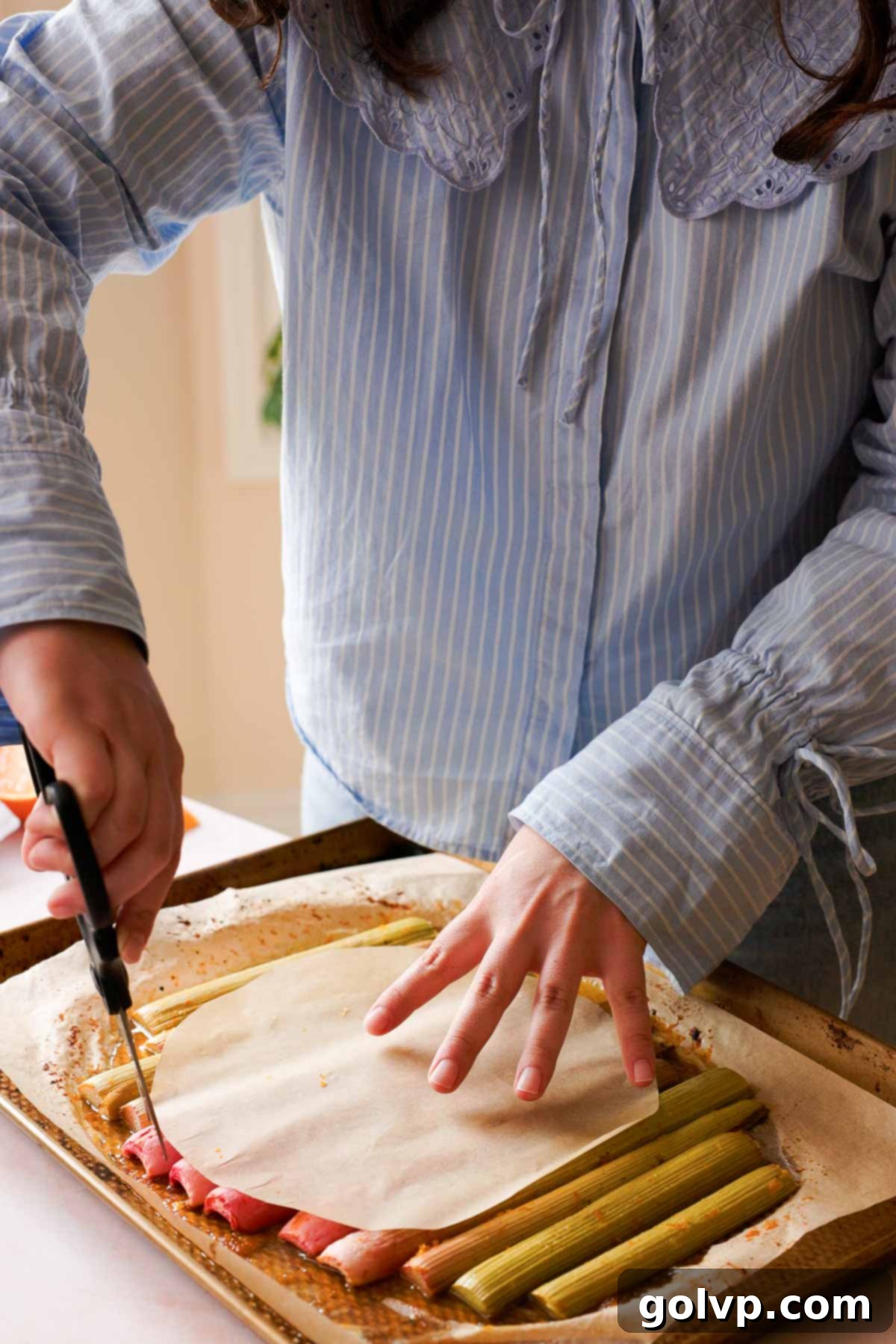
Step 3: Create the Decorative Rhubarb Topping. Once roasted, allow the rhubarb to cool completely on the baking sheet. To prepare the beautiful top layer, take a piece of parchment paper and trace the bottom of your cheesecake’s springform pan, then cut out the circle. Arrange your prettiest rhubarb stalks side by side, “pretty side up,” on this parchment circle. Place the parchment circle on top of the arranged rhubarb. Using a very sharp knife or kitchen scissors, carefully cut around the parchment paper to create a perfect circle of roasted rhubarb.
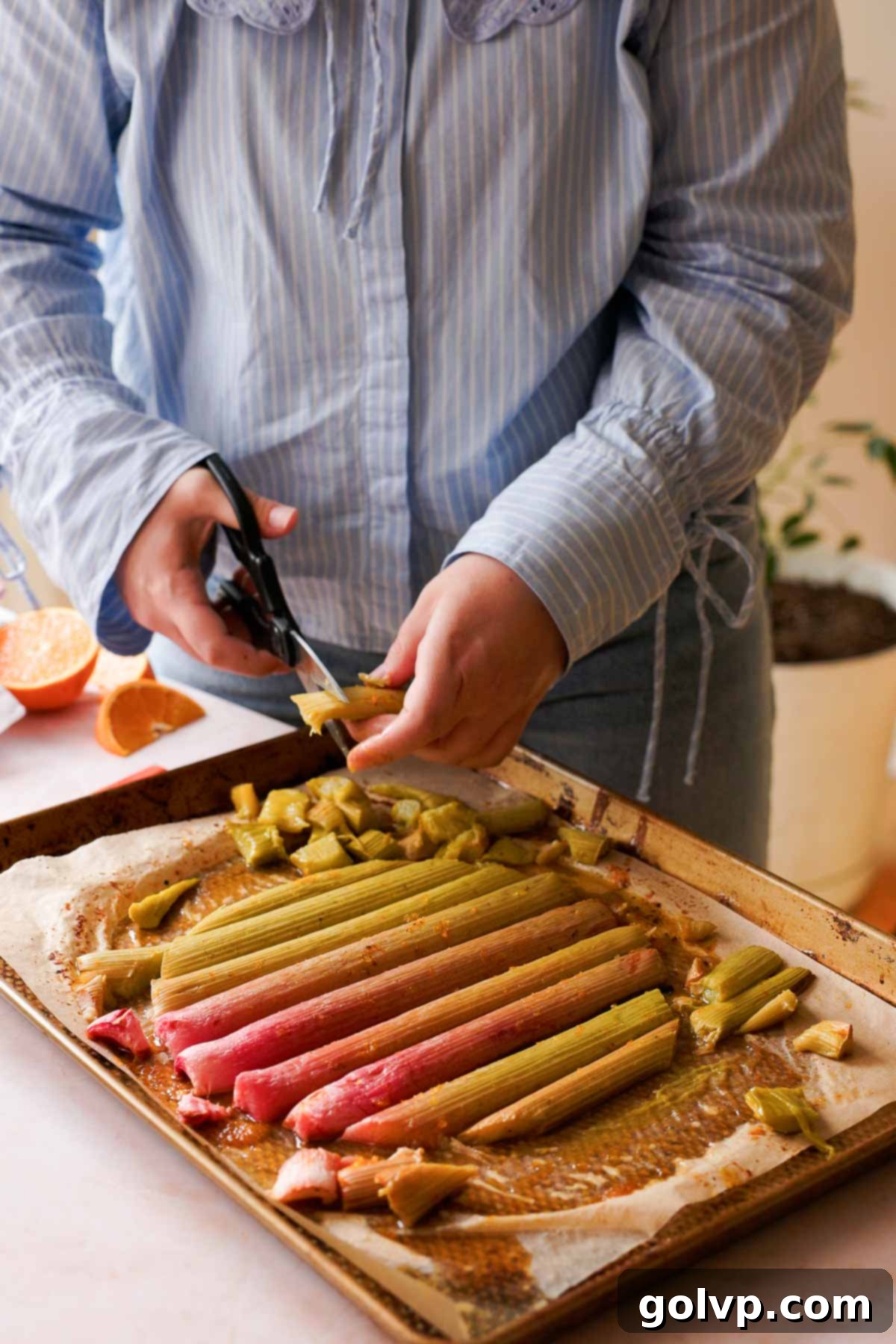
Step 4: Prepare Rhubarb for the Filling. Carefully remove any excess rhubarb that falls outside of your cut circle. Take these leftover pieces and chop them into smaller, bite-sized chunks. These smaller pieces will be incorporated into the cheesecake batter itself, adding bursts of tangy fruit throughout the dessert. Cover the rhubarb circle destined for the topping and refrigerate it. This chilling helps it set and makes it easier to handle when you’re ready to decorate your cheesecake.
Cinnamon Graham Cracker Crust Step-by-Step
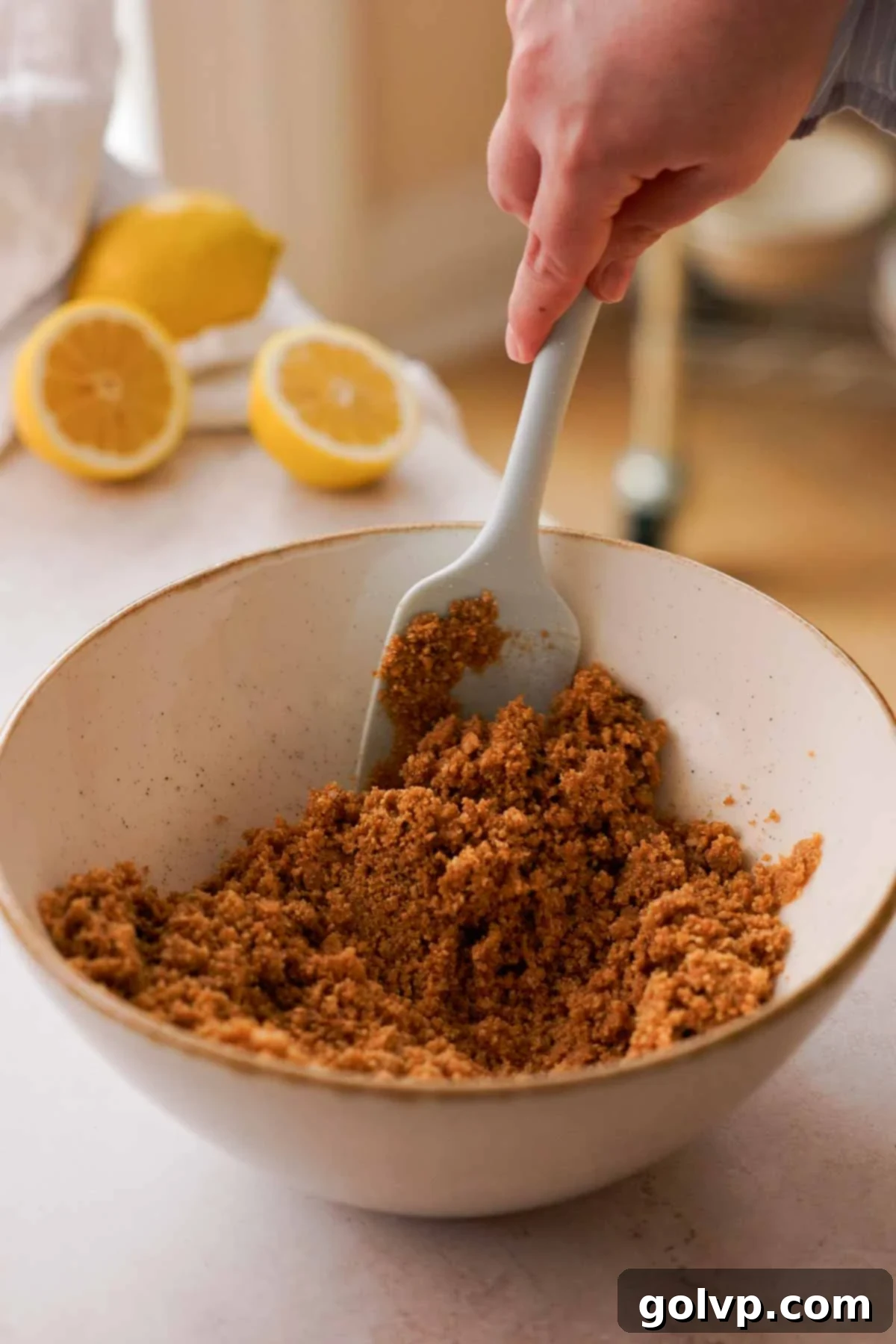
Step 1: Combine Dry and Wet Ingredients. In a large mixing bowl, combine the crushed graham crackers, packed brown sugar, ground cinnamon, and a pinch of sea salt. Stir these dry ingredients together thoroughly to ensure the spices and sugar are evenly distributed. Next, pour in the melted unsalted butter. Mix again until the crumbs are uniformly moistened and resemble wet sand. The butter acts as a binder, creating a firm crust.
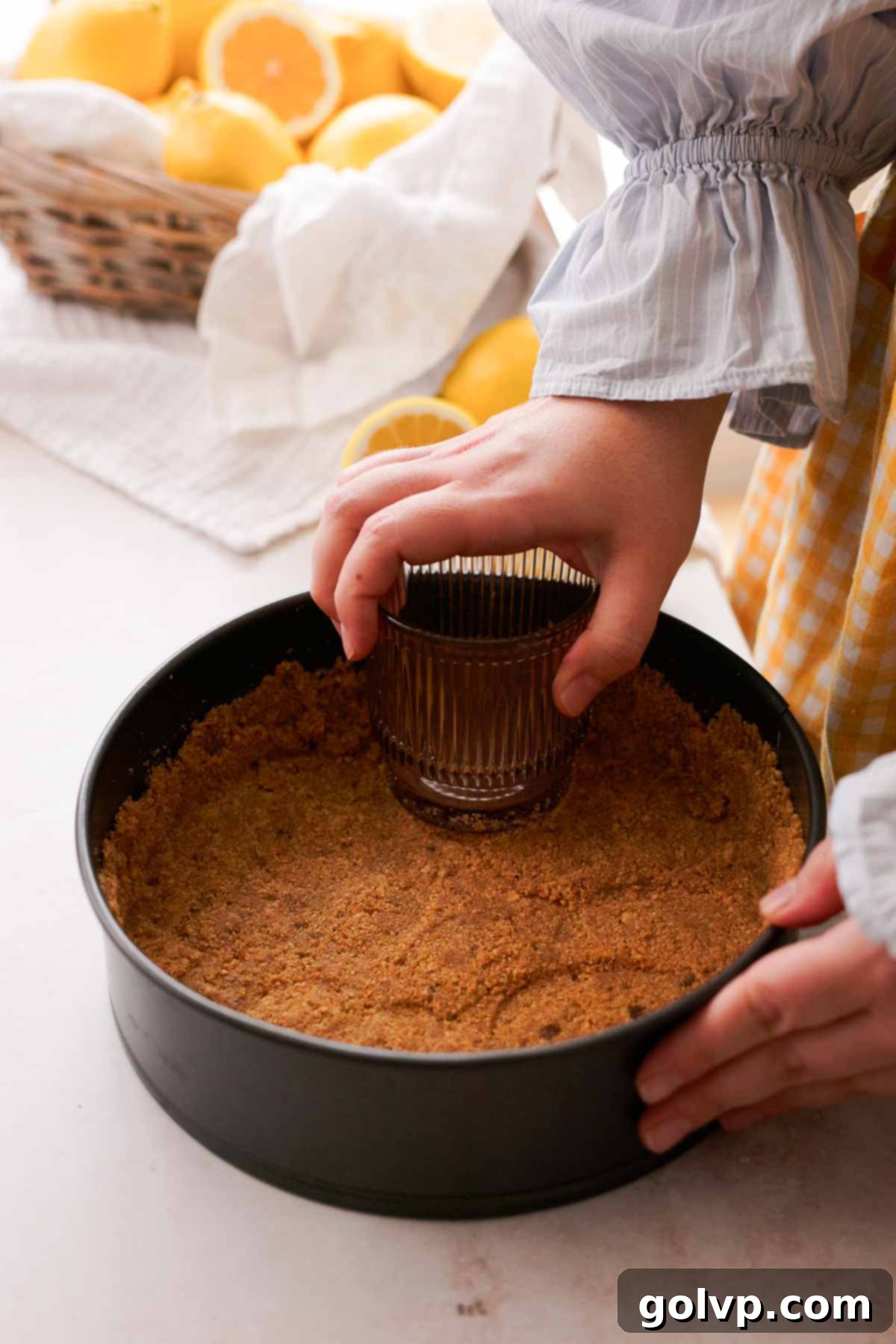
Step 2: Form the Crust. Transfer the buttery graham cracker mixture into your prepared springform pan. Use the bottom of a flat-bottomed glass or your fingers to firmly press the crumbs evenly into the bottom of the pan and about halfway up the sides. A well-pressed crust is crucial to prevent crumbling when sliced. The compact crumbs will create a sturdy and delicious base for your cheesecake.
Step 3: Bake the Crust. Place the springform pan containing the crust onto a larger baking sheet (this helps catch any potential butter drips and makes it easier to transfer). Bake in your preheated 320°F (160°C) oven for about 10-12 minutes. Pre-baking the crust helps to set it, making it extra crisp and flavorful before the cheesecake batter is added.
Creamy Cheesecake Batter Step-by-Step

Step 1: Combine Sugar and Cornstarch. In a large mixing bowl, or the bowl of a stand mixer fitted with the paddle attachment, thoroughly stir together the granulated sugar and cornstarch. This initial step ensures that the cornstarch is evenly dispersed, preventing lumps and aiding in the smooth setting of the cheesecake. It also helps to prevent overmixing once the cream cheese is added.
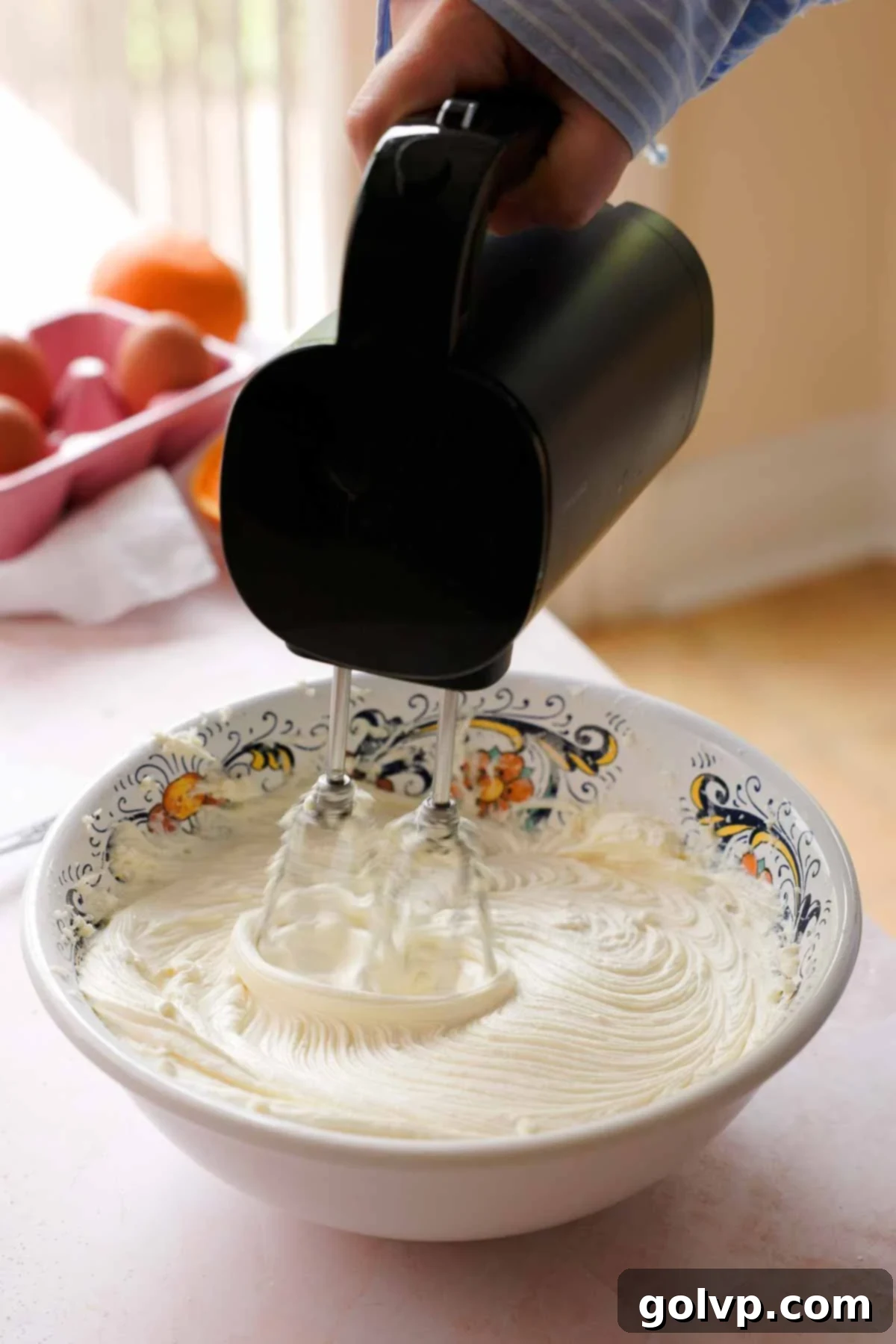
Step 2: Cream the Cream Cheese. Add the room-temperature brick-style cream cheese to the sugar and cornstarch mixture. Beat on medium speed until the mixture is completely smooth and creamy, with no lumps visible. This usually takes a few minutes. Make sure to scrape down the sides and bottom of the bowl frequently with a rubber spatula to ensure everything is well combined and evenly incorporated.
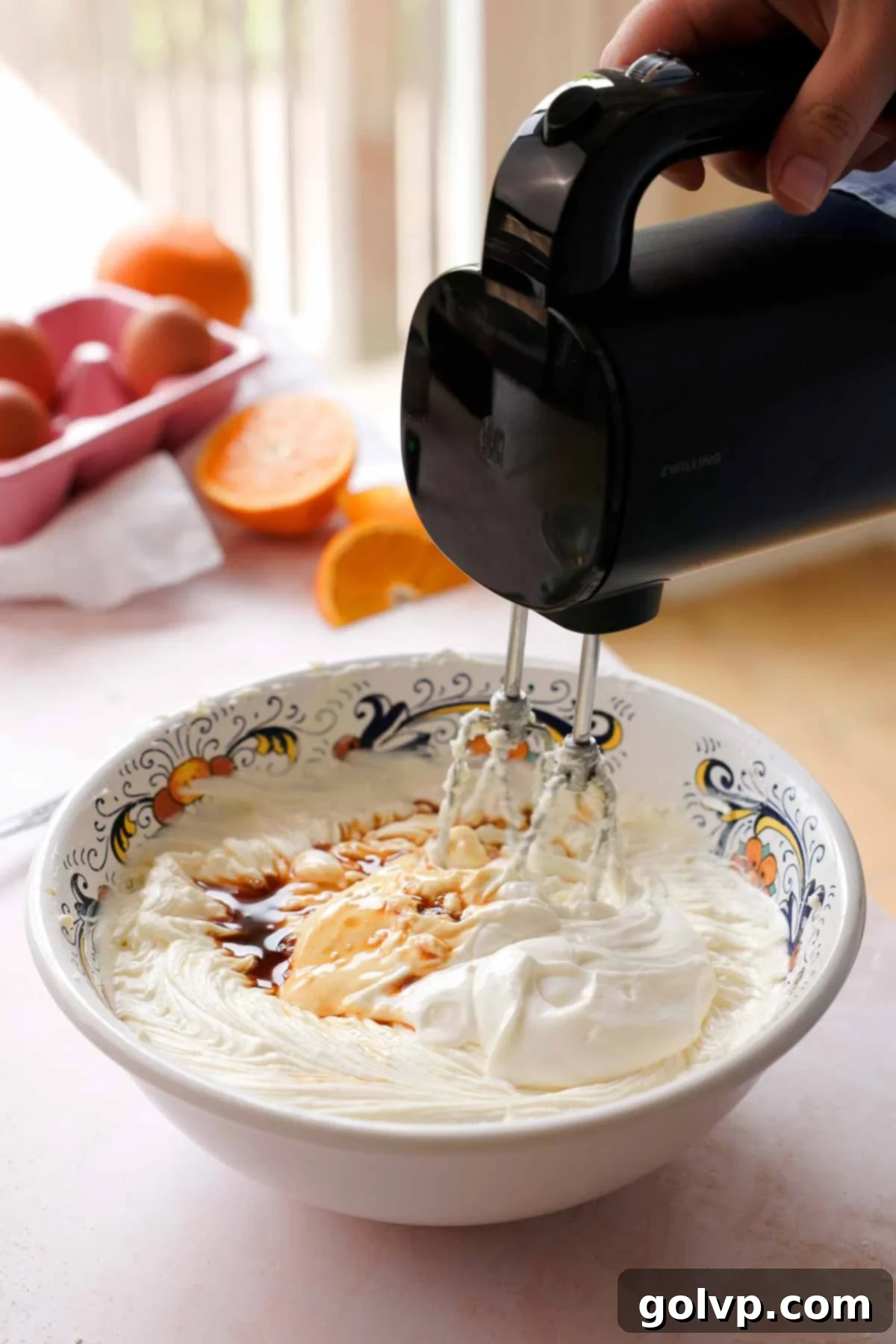
Step 3: Add Sour Cream, Vanilla, and Salt. Incorporate the room-temperature sour cream, pure vanilla extract (or vanilla bean paste), and sea salt into the cream cheese mixture. Beat on low speed until just combined. Again, scrape down the bowl to ensure all ingredients are thoroughly mixed. These additions enhance the flavor and contribute to the cheesecake’s characteristic tang and smooth texture.
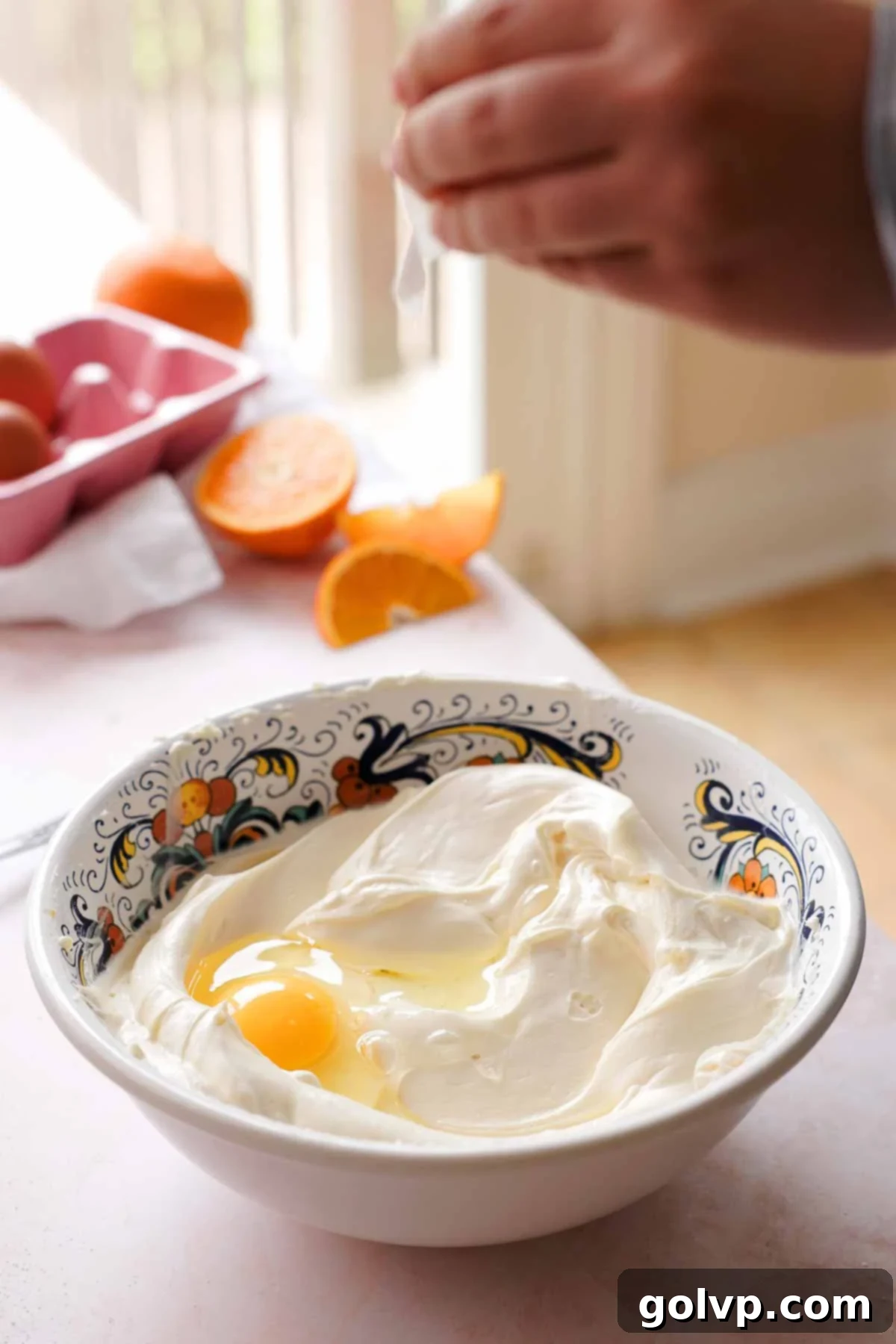
Step 4: Incorporate Eggs Gradually. Add the large eggs one by one, mixing on the lowest speed just until each egg is fully incorporated into the batter. This step is crucial: avoid overmixing the eggs. Overmixing introduces too much air into the batter, which can cause the cheesecake to puff up excessively in the oven and then crack as it cools. Gentle mixing ensures a dense, crack-free, and creamy result.
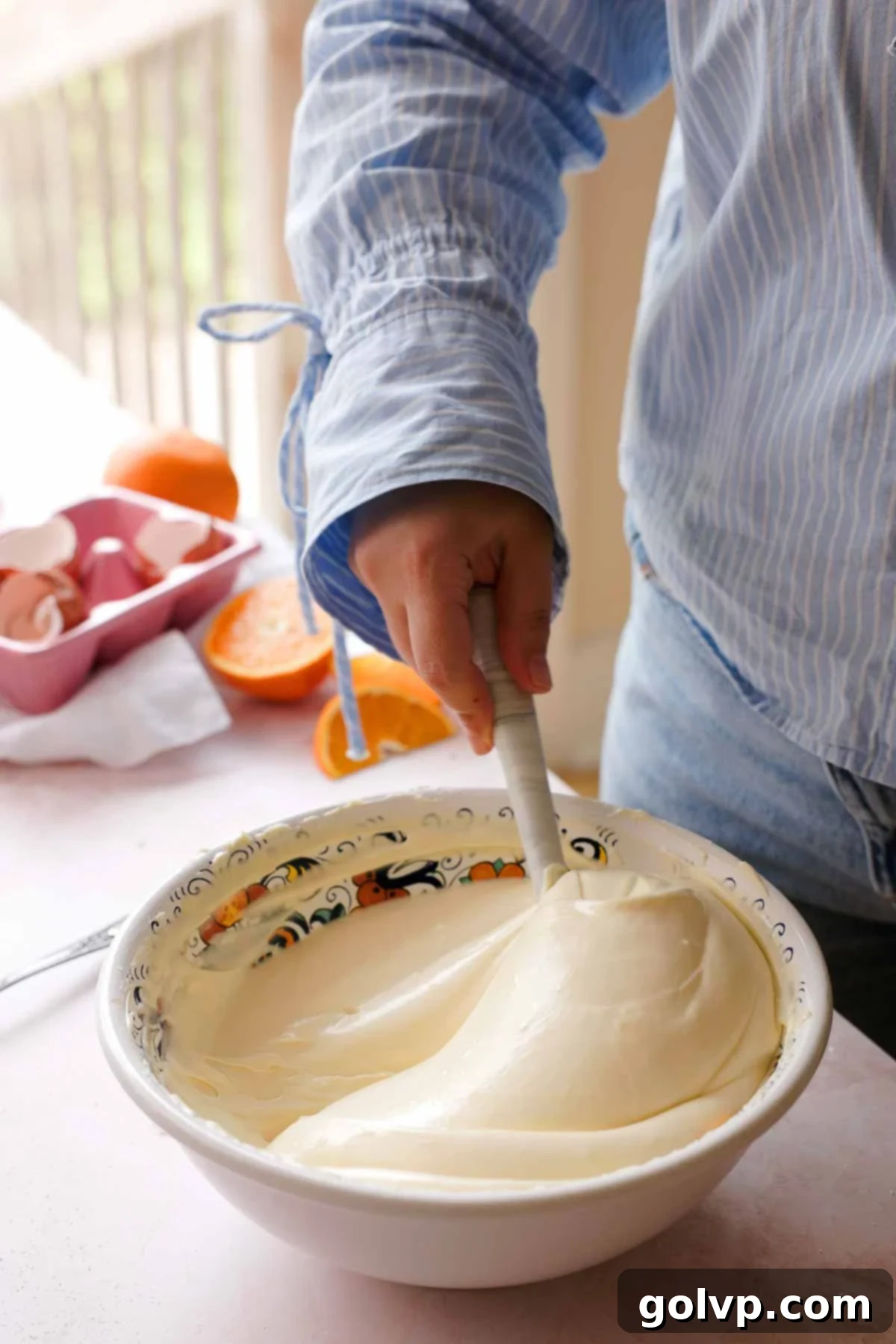
Step 5: Final Check for Smoothness. After adding each egg, remember to scrape down the sides and bottom of the bowl to ensure all ingredients are perfectly blended. The final batter should be smooth, velvety, and consistent, without any visible streaks of egg or unincorporated cream cheese. Remember, minimal mixing after the eggs are added is key for a perfect baked cheesecake.
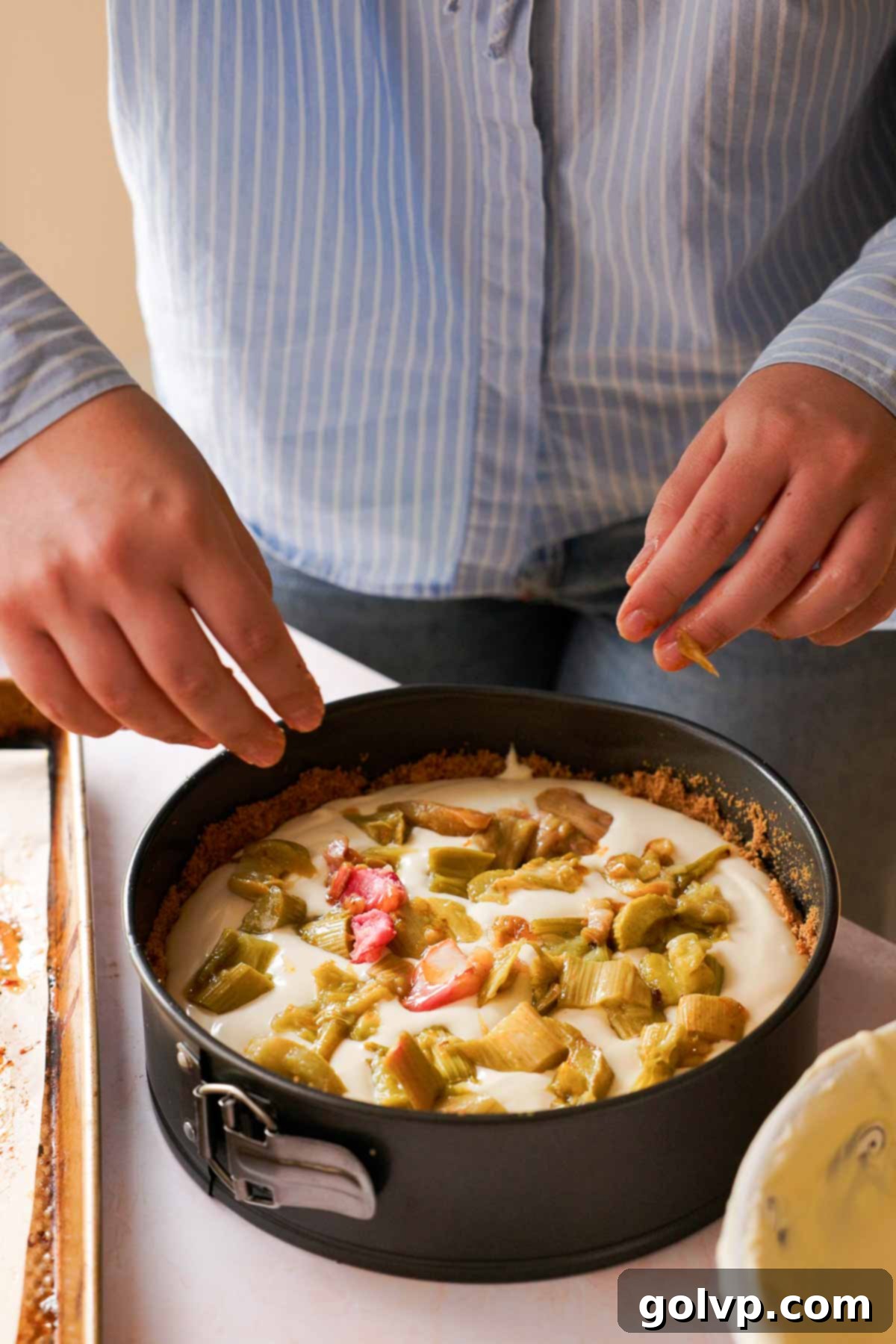
Step 6: Layer the Rhubarb into the Cheesecake. Pour approximately half of the prepared cheesecake batter evenly into the pre-baked graham cracker crust. Then, carefully distribute the reserved small pieces of roasted rhubarb over the batter. Lay them out as evenly as possible to ensure that every slice of cheesecake gets a delightful taste of the tangy fruit. This layering creates a beautiful cross-section when the cheesecake is cut.
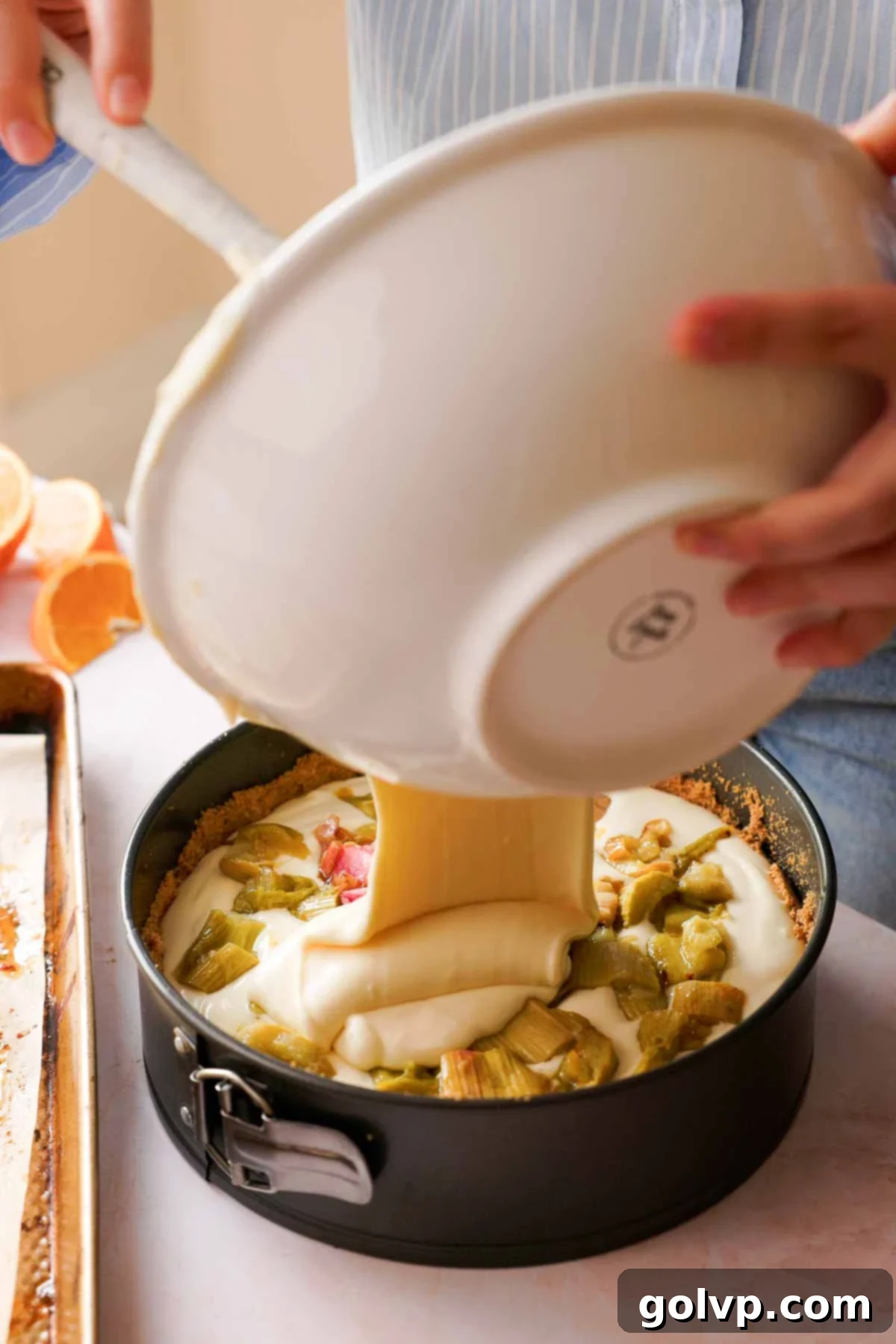
Step 7: Top with Remaining Batter. Gently spoon the remaining cheesecake batter over the layer of roasted rhubarb. Take care to cover the rhubarb pieces completely and smooth out the top with a spatula to create an even surface. This ensures the rhubarb remains suspended within the cheesecake and bakes beautifully.
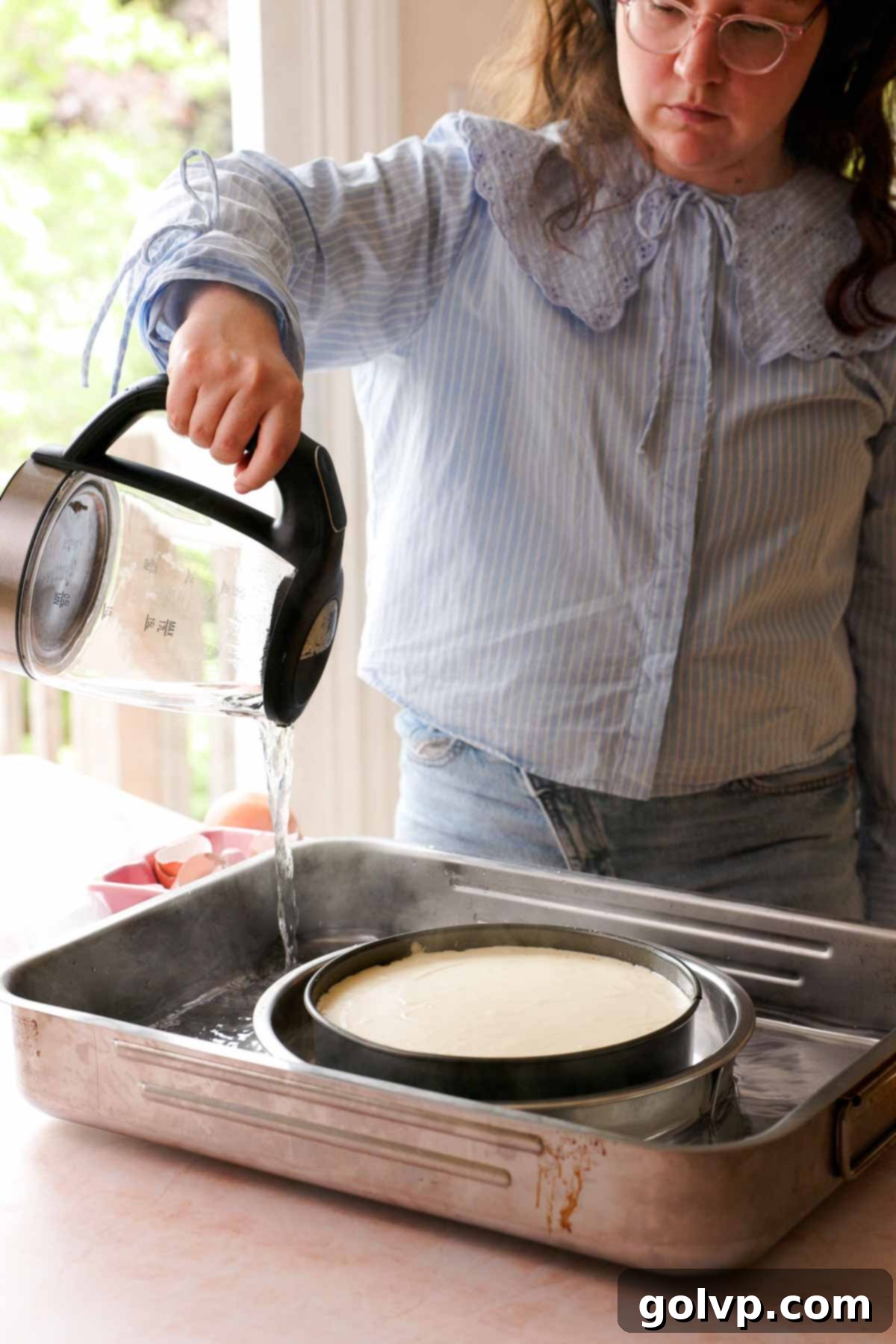
Step 8: Bake in a Water Bath. For a truly crack-free and creamy cheesecake, a water bath is essential. You’ll need a large baking tray and a smaller baking pan that can comfortably fit your cheesecake’s springform pan. Alternatively, wrap the bottom of your springform pan with several layers of heavy-duty aluminum foil to create a waterproof barrier. Place the entire assembly into the oven, then carefully pour boiling water into the outermost baking pan, ensuring the water level comes about halfway up the sides of the springform pan. Bake at 320°F (160°C) for approximately 1 hour and 30 minutes. The cheesecake is ready when the edges are set and slightly puffed, but the very center still has a slight jiggle when you gently wiggle the pan. Once baked, turn off the oven and leave the cheesecake inside with the oven door ajar for another 30 minutes. This gradual cooling prevents sudden temperature changes that can lead to cracks.
Step 9: Cool and Chill. Remove the cheesecake from the oven and the water bath. Let it cool completely at room temperature on a wire rack. Once fully cooled, transfer it to the refrigerator. Allow the cheesecake to chill and set for at least 6 hours, or ideally, overnight. This chilling period is crucial for the cheesecake to firm up, achieve its signature dense and creamy texture, and allow the flavors to fully develop and meld.
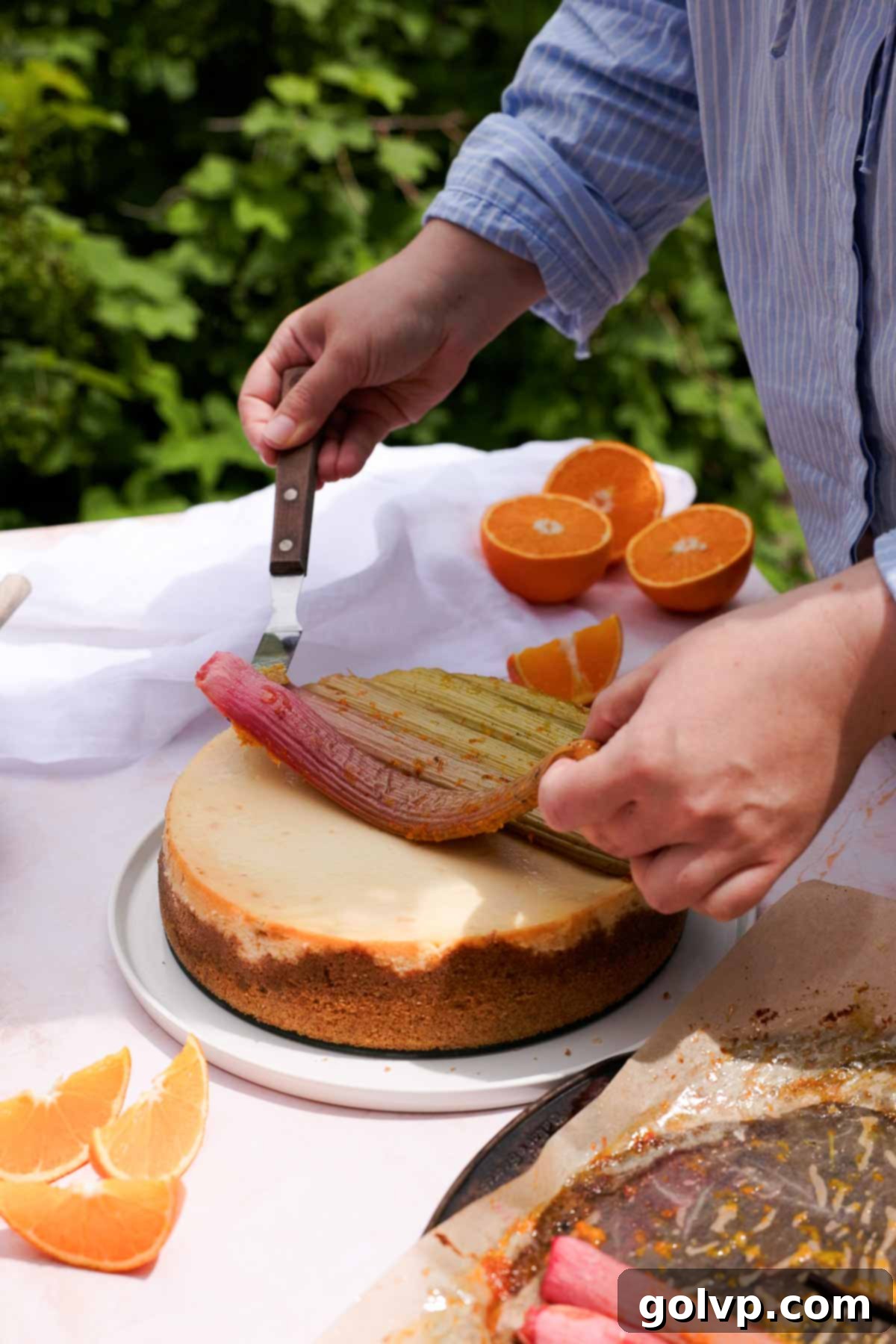
Step 10: Decorate Your Masterpiece. Once the cheesecake is thoroughly chilled, run a thin, sharp knife around the inside edge of the springform pan to loosen the cheesecake. Carefully release and remove the springform ring. Now, gently place the chilled disk of beautiful roasted rhubarb on top of the cheesecake. Spoon any leftover flavorful syrup from the roasting pan over the rhubarb for extra glaze and moisture. For an added touch of elegance, decorate with edible flowers (such as violas or pansies) if desired, to enhance its visual appeal.
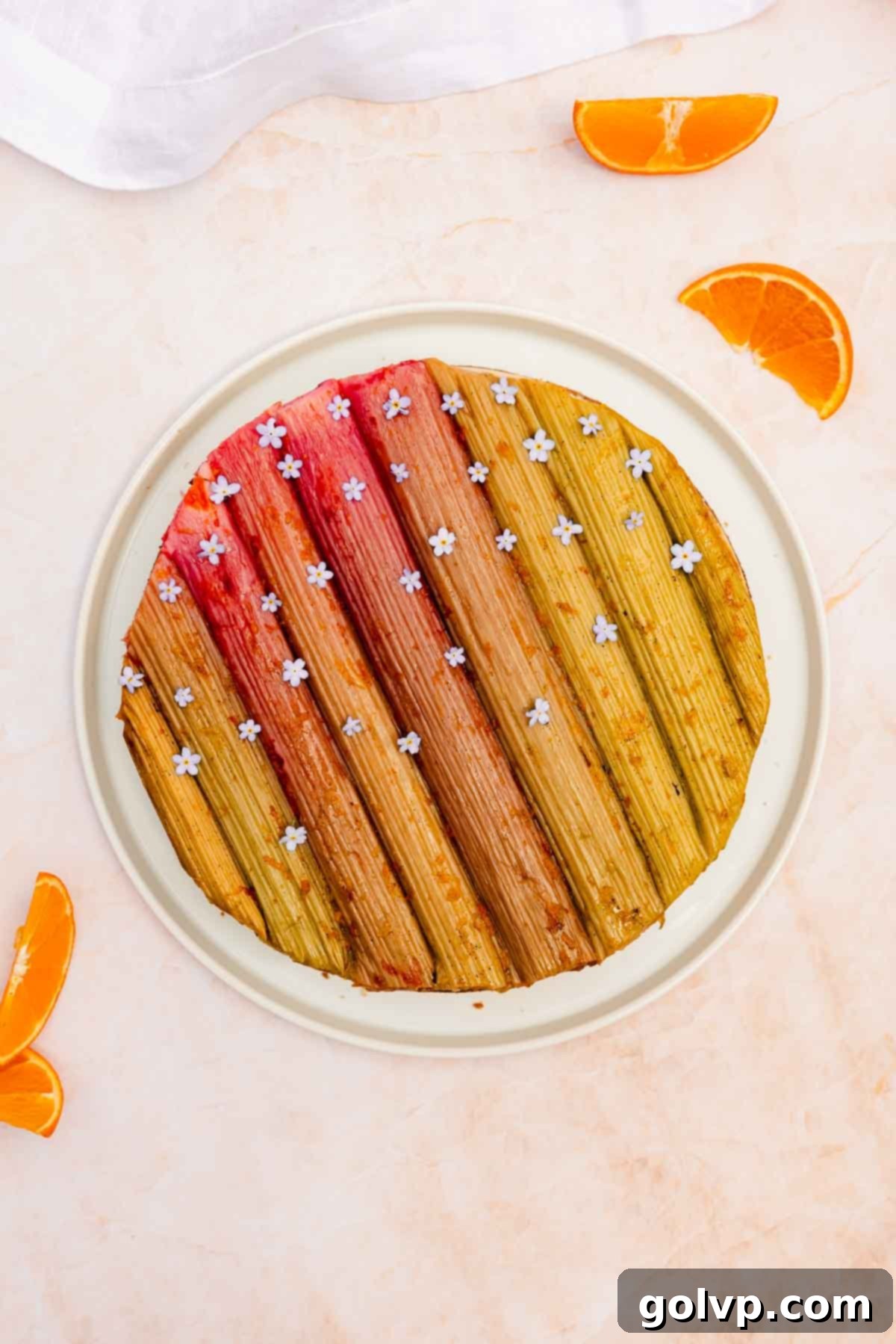
Step 11: Slice and Serve. Keep the cheesecake refrigerated until you are ready to slice and serve. When cutting, use a sharp, thin-bladed knife. For the cleanest slices, especially through the rhubarb topping, use a gentle sawing motion rather than pressing straight down. You can wipe the knife clean between each slice for a pristine presentation. This rhubarb cheesecake is best enjoyed cold, allowing all its layers of flavor and texture to shine.
✔️ Expert Rhubarb Cheesecake Tips for Success
- Avoid Overcooking the Rhubarb: While roasting concentrates the flavors, be vigilant about the cooking time. Rhubarb should be tender but still hold its structural integrity. If it becomes too soft or mushy, it will lose its distinct shape and texture, which is crucial for both the layered filling and the decorative topping. Check it frequently towards the end of the recommended roasting time.
- Top the Cheesecake After Cooling and Chilling: It’s tempting to add the beautiful rhubarb topping immediately, but patience is key. Placing the rhubarb on top after the cheesecake has completely cooled and chilled prevents it from sinking into the still-soft batter or creating unsightly cracks on the surface due to uneven cooling or weight distribution. A cold cheesecake provides a stable base for your decorative layer.
- Always Use a Water Bath for Baked Cheesecakes: The water bath (bain-marie) is your secret weapon for a flawless cheesecake. It ensures even, slow baking by providing a moist, gentle heat environment. This slow baking process is essential for preventing the cheesecake from cracking on top, creating an incredibly creamy texture from edge to center, and ensuring it cooks through without drying out.
- Do Not Overbake the Cheesecake: An overbaked cheesecake is a dry, cracked cheesecake. You’ll know your cheesecake is perfectly ready when the outer edges are set and slightly puffed, but the very center (about 2-3 inches in diameter) still has a slight, delicate jiggle when you gently shake the pan. The residual heat will continue to cook it as it cools, leading to a perfectly set yet creamy interior.
- Ensure All Dairy Ingredients are at Room Temperature: This is a non-negotiable tip for achieving a silky-smooth, lump-free cheesecake batter. Room temperature cream cheese, sour cream, and eggs blend together effortlessly, creating a homogenous mixture without requiring excessive mixing. Overmixing can incorporate too much air, leading to cracks in the final product.
- Don’t Overmix the Batter, Especially After Adding Eggs: Once the eggs are introduced, mix the batter on the lowest speed possible and only until each egg is just incorporated. Overmixing at this stage can incorporate too much air, which causes the cheesecake to rise rapidly and then fall dramatically, resulting in cracks and a less dense texture.
🥄 Make Ahead and Storage
This Vanilla Orange Roasted Rhubarb Cheesecake is an excellent dessert to prepare in advance, as it actually benefits from a long chilling period. You can easily make the entire cheesecake two days before you plan to serve it, allowing ample time for it to set properly and for all the flavors to deepen and meld beautifully. Store the finished cheesecake in an airtight container in the refrigerator for up to 5 days, ensuring it remains fresh and delicious.
If you find yourself with leftovers, or if you intentionally want to prepare and store portions for future enjoyment, this cheesecake freezes exceptionally well. Simply slice any remaining cheesecake into individual portions, wrap each slice tightly in plastic wrap, and then place them in an airtight freezer-safe bag or container. It can be frozen for up to 2 months. When you’re ready to enjoy, thaw individual slices overnight in the refrigerator.
A specific note on freezing: If your primary intention is to bake this cheesecake and freeze it for more than a week or two, I highly recommend substituting the cornstarch with arrowroot starch or potato starch in the cheesecake batter. Cornstarch can sometimes break down when frozen and thawed, potentially affecting the cheesecake’s texture. Arrowroot or potato starch, however, maintain their thickening properties better through the freezing and thawing process, ensuring your cheesecake remains perfectly creamy.
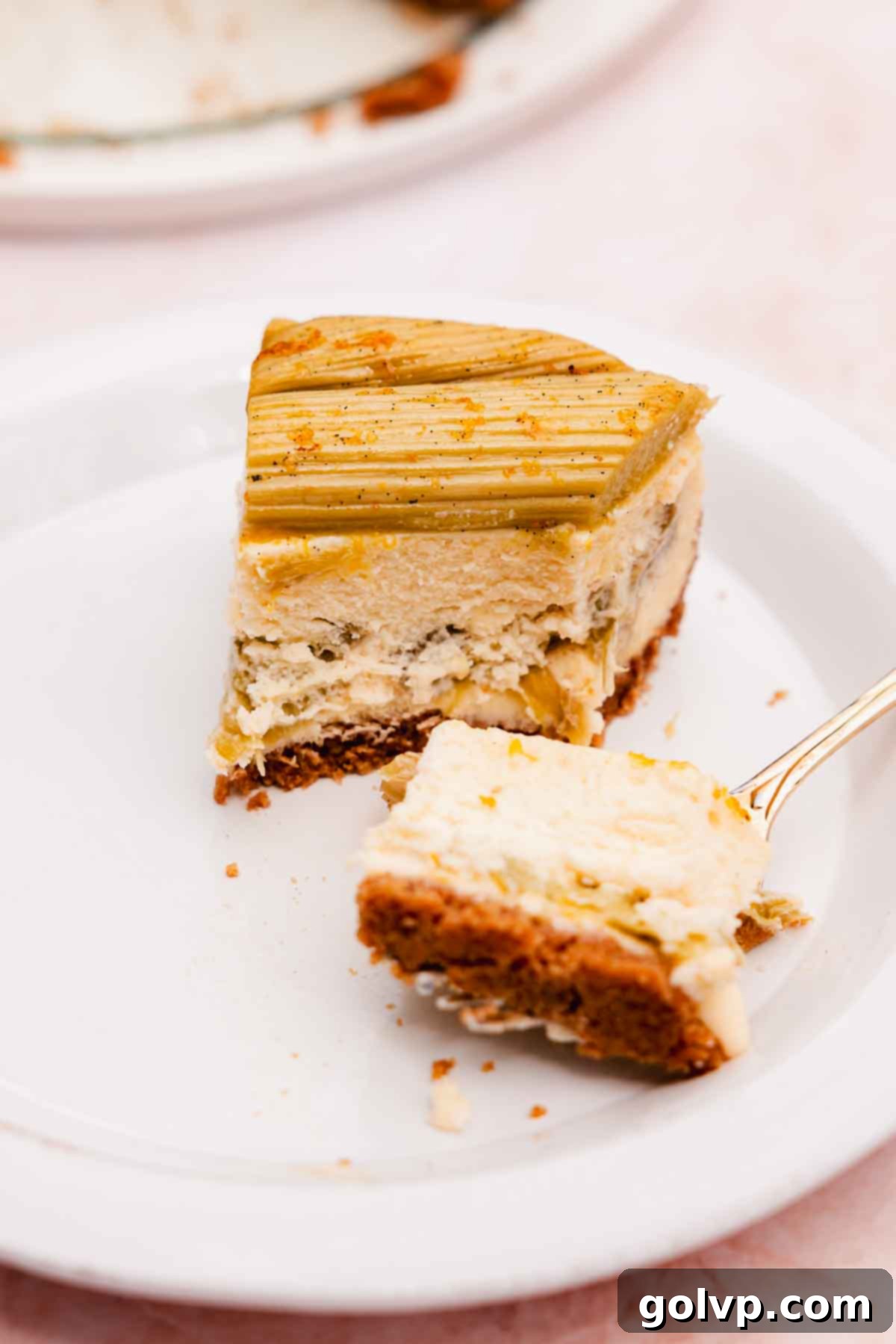
❔ Why Roast Rhubarb? The Secret to Enhanced Flavor and Texture
Roasting rhubarb is a culinary revelation, offering a far superior experience compared to simply stewing or boiling it. This gentle cooking method concentrates the rhubarb’s naturally tart flavors, transforming them into a more complex, almost caramelized sweetness while still retaining that signature tang. The dry heat of the oven also helps to maintain the rhubarb’s structural integrity, ensuring that it remains tender yet holds its shape beautifully – a crucial factor for both the layered filling and the visually appealing topping of our cheesecake. This prevents it from turning into a watery, mushy compote.
When you roast rhubarb with companions like freshly squeezed and zested orange and aromatic vanilla bean, you unlock an incredible synergy of flavors. The orange adds a bright, zesty counterpoint and a subtle citrusy sweetness, while the vanilla infuses a warm, fragrant depth. The result is not just perfectly tender rhubarb, but also a luscious, tangy syrup that forms around it, ideal for drizzling over the cheesecake or other desserts. This versatile roasted rhubarb is not only perfect for topping rich, creamy cakes like this rhubarb cheesecake, but it also pairs exceptionally well with a scoop of brown butter ice cream, yogurt, or even as a vibrant addition to breakfast oats. I consistently find that the unique tartness of rhubarb truly shines brightest when paired with rich, custardy, or creamy elements, making cheesecake, crème brûlée, or ice cream its ideal companions.
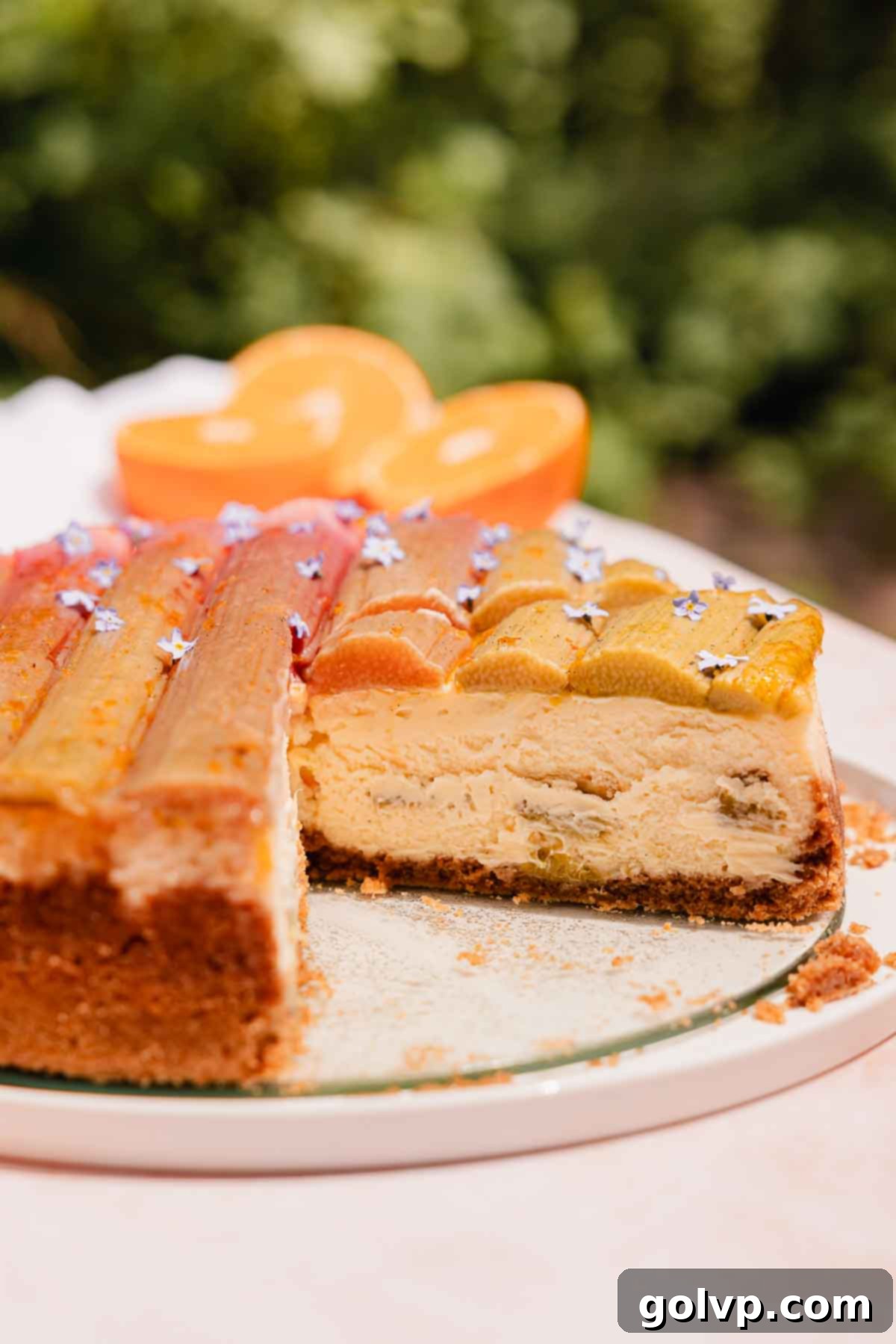
📖 Rhubarb Cheesecake Recipe FAQs
The secret to a truly silky, lump-free cheesecake batter lies in two key practices: ensuring all your dairy ingredients (cream cheese, sour cream, and eggs) are at absolute room temperature, and diligently scraping down the mixing bowl. When fats in the cream cheese and sour cream are soft, they emulsify beautifully with the sugar and other liquids, preventing grainy textures. Scraping the bowl frequently ensures that no pockets of unmixed ingredients are left behind, resulting in a perfectly homogenous and smooth batter.
Cheesecake cracks are a common frustration, typically caused by one of three issues: overbaking, an oven temperature that is too high, or neglecting to use a water bath. Overbaking dries out the cheesecake, causing its surface to pull apart. High oven temperatures can cause the batter to rise too quickly and unevenly. To prevent this, always verify your oven temperature with a reliable oven thermometer, ensure you’re using a water bath for even moisture and gentle heat, and crucially, remove the cheesecake from the oven when the center still has a slight, delicate jiggle. The residual heat will continue to set it without overcooking.
The extended chilling time, at least 6 hours or preferably overnight, is absolutely vital for a perfectly set cheesecake. During this period, the cheesecake not only firms up to its ideal dense, creamy texture but also allows the flavors to fully develop and deepen. Just like a good stew or curry tastes better the next day, the ingredients in a cheesecake need time for their essences to meld, resulting in a much more delicious and harmonious dessert. Rushing this step will result in a soft, possibly runny cheesecake that is difficult to slice and less flavorful.
Yes, you can absolutely use frozen rhubarb, especially for the diced pieces that are mixed into the cheesecake batter. There’s no need to thaw it beforehand for roasting; you can roast it directly from frozen. Just be aware that frozen rhubarb may release more moisture and might roast slightly faster or require a few extra minutes to achieve the desired tenderness, so keep a close eye on it. For the decorative top layer, fresh rhubarb is ideal for its firmer texture and vibrant appearance, but frozen can work if carefully selected and roasted.
🍰 More Related Cheesecake Recipes
- Lemon Poppy Seed Cheesecake
- Lemon Blueberry Cheesecake
- Lemon Raspberry Cheesecake
- Strawberry Crunch Cheesecake
Did you make this recipe? I would love for you to rate this recipe and hear what you think in the comments below! Share your creation on Instagram and tag @flouringkitchen. Follow me on Pinterestto save and for more recipe ideas.
📖 Recipe
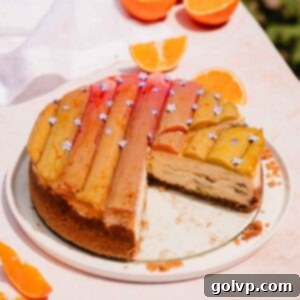
Rhubarb Cheesecake
Mary
Pin Recipe
Shop Ingredients
Equipment
-
electric mixer
-
nine inch springform round baking pan
Ingredients
Vanilla Orange Roasted Rhubarb
- 1 ½ pounds rhubarb 700g
- ¼ cup granulated sugar
- 1 teaspoon vanilla bean paste or 1 whole vanilla bean
- 1 orange zested and juiced, about ½ cup juice
Cheesecake Crust
- 2 cups graham cracker crumbs
- 2 tablespoons brown sugar packed
- ½ teaspoon cinnamon ground
- ¼ teaspoon sea salt
- ½ cup unsalted butter melted
Cheesecake Batter
- 1 cup granulated sugar
- 3 tablespoons cornstarch
- 24 oz cream cheese three 8oz bricks, brick style, full fat, at room temperature
- ½ cup sour cream room temperature
- 1 tablespoon pure vanilla extract
- ½ teaspoon sea salt
- 3 large eggs room temperature
Shop Ingredients on Jupiter
Instructions
Vanilla Orange Roasted Rhubarb
-
Preheat oven to 320°F (160°C). Spread rhubarb on a parchment lined baking sheet and add sugar, vanilla paste, grated orange zest, and orange juice. Spread the mixture around to coat the rhubarb. If you have very thick rhubarb stalks, you can cut them in half lengthwise.1 ½ pounds rhubarb, ¼ cup granulated sugar, 1 teaspoon vanilla bean paste, 1 orange
-
Bake rhubarb in the preheated oven for about 20 minutes, until it’s soft when poked with a knife. You don’t want it to be too soft or it will fall apart, so I recommend checking it every few minutes after 18 minutes of baking.
-
Let the rhubarb cool on the baking sheet. Then, trace the bottom of your cheesecake’s spring form pan onto a piece of parchment paper and cut it out. Arrange the rhubarb side by side, pretty side up, and place the circle of parchment paper on top. Using a very sharp knife or kitchen scissors, cut out a circle of rhubarb.
-
Remove the excess rhubarb and cut them up into pieces. Set the pieces aside, they go into the cheesecake. Cover the rhubarb circle and refrigerate. This will go on top of the cheesecake.
Cheesecake Crust
-
Combine crushed graham crackers, brown sugar, cinnamon, and salt in a large bowl. Give it a quick stir. Add melted butter and stir again.2 cups graham cracker crumbs, 2 tablespoons brown sugar, ½ teaspoon cinnamon, ½ cup unsalted butter, ¼ teaspoon sea salt
-
Transfer the crumbs into the springform pan and press the crumbs halfway up the sides of the pan. Press the crumbs into the bottom of the pan with the bottom of a glass.
-
Place the springform pan onto a larger pan and bake for 12 minutes at 320°F (160°C).
Cheesecake Batter
-
Stir together sugar and cornstarch in a large bowl or stand mixer.1 cup granulated sugar, 3 tablespoons cornstarch
-
Add cream cheese into the sugar cornstarch mixture and beat together until creamy.24 oz cream cheese
-
Add sour cream, vanilla extract, and salt. Beat well, and scrape down the bowl.½ cup sour cream, 1 tablespoon pure vanilla extract, ½ teaspoon sea salt
-
Then, add the eggs, one by one, mixing just until each egg is incorporated. Scrape the bowl between each egg. Don’t over mix.3 large eggs
-
Pour half of the cheesecake batter into the baked crust. Then, add the roast rhubarb pieces on top, laying them out as evenly as you can. Carefully spoon over the remaining cheesecake batter.
-
You will need a large baking tray and a smaller baking pan that will fit the cheesecake springform pan. Alternatively, use an extra large piece of foil and wrap it around the bottom of the springform pan.
-
Place the baking pans into the oven and carefully pour boiling water into the outermost baking pan. Bake at 320°F (160°C) for 1 hour and 30 minutes. It’s ready when the edges are set and the inside is puffed but still jiggly. Turn the oven off and leave the cheesecake in the oven for 30 minutes.
-
Remove the cheesecake and let it cool at room temperature before refrigerating and letting it set in the fridge for at least 6 hours or overnight.
-
Run a knife around the outside of the cheesecake and remove the ring. Then, carefully arrange the disk of roast rhubarb on top. Spoon any leftover syrup over the rhubarb and decorate with edible flowers (optional).
-
Refrigerate until you’re ready to slice and serve! Use a sharp knife and a sawing motion to cut through the rhubarb.
Notes
Store the cheesecake in the fridge for up to 5 days – it’s the perfect make ahead cake because it needs to set in the fridge for at least 6 hours or overnight. You can freeze any leftovers that you may have in an airtight bag or container for up to 2 months.
If you plan on baking the cheesecake and freezing it to enjoy in a week or two, I recommend using arrowroot starch or potato starch instead of cornstarch as cornstarch doesn’t freeze and thaw well.
Tips for Success
- Don’t overcook the rhubarb, or it will turn to mush!
- Top the cheesecake with rhubarb after the cheesecake cools
- Use a water bath for even baking without cracks
- The cheesecake is ready when the center is puffed and jiggles when you wiggle the pan.
